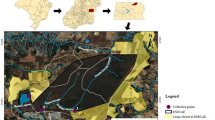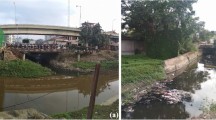Abstract
The present paper aims to assess the phytoremediation performance based on pollution removal efficiency of the highly polluted region of Alur Ilmu urban river for its applicability of on-site treatment. Thirteen stations along Alur Ilmu were selected to produce thematic maps through spatial distribution analysis based on six water quality parameters of Malaysia’s Water Quality Index (WQI) for dry and raining seasons. The maps generated were used to identify the highly polluted region for phytoremediation applicability assessment. Four free-floating plants were tested in treating water samples from the highly polluted region under three different conditions, namely controlled, aerated and normal treatments. The selected free-floating plants were water hyacinth (Eichhornia crassipes), water lettuce (Pistia stratiotes), rose water lettuce (Pistia sp.) and pennywort (Centella asiatica). The results showed that Alur Ilmu was more polluted during dry season compared to raining season based on the water quality analysis. During dry season, four parameters were marked as polluted along Alur Ilmu, namely dissolve oxygen (DO), 4.72 mg/L (class III); ammoniacal nitrogen (NH3–N), 0.85 mg/L (class IV); total suspended solid (TSS), 402 mg/L (class V) and biological oxygen demand (BOD), 3.89 mg/L (class III), whereas, two parameters were classed as polluted during raining season, namely total suspended solid (TSS), 571 mg/L (class V) and biological oxygen demand (BOD), 4.01 mg/L (class III). The thematic maps generated from spatial distribution analysis using Kriging gridding method showed that the highly polluted region was recorded at station AL 5. Hence, water samples were taken from this station for pollution removal analysis. All the free-floating plants were able to reduce TSS and COD in less than 14 days. However, water hyacinth showed the least detrimental effect from the phytoremediation process compared to other free-floating plants, thus made it a suitable free-floating plants to be used for on-site treatment.













Similar content being viewed by others
References
Afina NAM, Othman AK, Ahmad DM (2015) The water quality study and sources of pollution in Alur Ilmu, UKM. Malays J Anal Sci 19(5):1137–1146
APHA (2005) Standard methods for the examination of water and wastewater, 21st edn. American Public Health Association, Washington, DC
Bashyal S (2010) Wastewater treatment by floating and emergent aquatic macrophytes in artificial wetland system. Sunmoon University, Asan
Brezonik PL, Stadelmann TH (2002) Analysis and predictive models of stormwater runoff volumes, loads, and pollutant concentrations from watersheds in the Twin Cities metropolitan area, Minnesota, USA. Water Res 36:1743–1757
Chong WL (1999) Effluent study of oxidation sewage pond and drainage system around National University of Malaysia(UKM) campus. National University of Malaysia, Bangi (in Malay)
Curriero FC (2007) On the use of non-Euclidean distance measures in geostatistics. Math Geol 38(8):907–926
DeBusk TA, Reddy KR (1993) Wastewater treatment and biomass production by floating aquatic macrophyte. In: Wastewater Treatment by Floating Macrophytes, Gainesville
DeBusk TA, Reddy KR, Hayes TD, Schwegler BR Jr (1989) Performance of a pilot-scale water hyacinth-based secondary treatment system. J WPCF 61(7):1217–1224
Din HM, Toriman ME, Mokhtar M, Elfithri R, Aziz NAA, Abdullah NM, Kamarudin MKA (2012) Loading concentrations of pollutant in Alur Ilmu at UKM Bangi campus: event mean concentration (EMC) approach. Malays J Anal Sci 16:353–365
DOE (2006) Malaysian Environmental Quality Report 2006: Water Quality Index Classification; Ministry of Natural Resources and Environment Malaysia. Department of Environment Malaysia, Putrajaya, Malaysia.
Ghafouri M, Swain CE (2005) Spatial analysis of urban stormwater quality. J Spat Hydrol Spring 5(1):33–46
Golden Software (2017) A basic understanding of surfer gridding methods. Retrived from https://support.golden software.com/hc/en-us/articles/ 23134 8728-A-Basic-Understanding-of-Surfer-Gridding-Methods-Part-1
Gregory L, Blumenthal B, Wagner K, Borel K, Karthikeyan R (2013) Estimating on-site sewage facility density and distribution using geo-spatial analyses. Nat Environ Sci 4(1):14–21
Kalubowila S, Jayaweera M, Nanayakkara CM, Gunatilleke DNDS (2014) Floating wetlands for management of algal washout from waste stabilization pond effluent: case study at hikkaduwa waste stabilization ponds. Eng J Inst Eng Sri Lanka 46:63–74
Kim Y, Giokas DL, Chung PG, Lee DR (2003) Design of water hyacinth ponds for removing algal particles from waste stabilization ponds. Water Sci Technol 48:115–123
Malaysia Metrological Department (MET) (2017) Seasonal rainfall variation in peninsular Malaysia Ministry of Science, Technology and Innovation (MOSTI). Retrieved from http://www.met.gov.my/web/metmalaysia/ climate/ generalinformation/Malaysia
Marsalek J, Jimenez-Cisneros B, Karamouz M, Malmquist P-A, Goldenfum J, Chocat B (2008) Urban water cycle processes and interactions. International Hydrological Programme (IHP) of the United Nations Educational, Scientific and Cultural Organization (UNESCO), Paris
Mazlin M, Chee FH, Chong WL, Ooi YY, Tan BH (2005) Study of “Alur Ilmu” water quality in UKM: towards integrated water resource management approach. Malays J Analyt Sci 12(3):388–395 (in Malay)
Murphy RR, Curriero FC, Ball WP (2010) Comparison of spatial interpolation methods for water quality evaluation in the Chesapeake Bay. J Environ Eng 136(2):160–171. https://doi.org/10.1061/(ASCE)EE.1943-7870.0000121
O’Halloran J Walsh AR Fitzpatrick PJ (1997) The determination of trace elements in biological and environmental samples using atomic absorption spectroscopy. In: Sheehan D (ed.). Methods in biotechnology, bioremediation protocols, vol 2. Humana Pres: New Jersey Series no.12 Queensland Government publishers, Brisbane
Sadler R Rynja G (1992) Preservation, storage, transport, analysis and reporting of water samples. Queensland Goverment Chemical Laboratory Report
Shah M, Hashmi HN, Ali A, Ghumman AR (2014) Performance assessment of aquatic macrophytes for treatment of municipal wastewater. J Environ Health Sci Eng 12:–106
Shu X Zhang QF Wang WB (2014) Effects of temperature and light intensity on growthand physiology in purple root water hyacinth and common water hyacinth (Eichhornia crassipes)
Snow AM, Ghaly AE (2008) A comparative study of the purification of aquaculture wastewater using water hyacinth, water lettuce and parrot’s feather. Am J Appl Sci 5(4):440–453
Subramani T, Subramanian A, Kathirvel C, Bharathi Devi SK (2014) Analysis and site suitability evaluation for textile sewage water treatment plant in Salem Corporation, Tamilnadu using remote sensing techniques. Int J Eng Res Appl 8(6):90–102
Thomas ND, Reese AJ (1995) Municipal stormwater management. Lewis publishers, London
Universiti Kebangsaan Malaysia (UKM) (1978) Inventori Infrastruktur Universiti Kebangsaan Malaysia 1978/1979. Bangi
Valipour A, Raman VK, Ahn Y-H (2015) Effectiveness of domestic wastewater treatment using a bio-hedge water hyacinth wetland system. Water 7(1):329–347
Wang Z, Zhang Z, Zhang Y, Zhang J, Yan S, Guo J (2013) Nitrogen removal from Lake Caohai, a typical ultra-eutrophic lake in China with large scale confined growth of Eichhornia crassipes. Chemosphere 92(2):177–183
Washington State Department of Health (2005) Nitrogen reducing technologies for onsite wastewater treatment systems. Olympia
Western Australia Department of Water (2009) Surface water sampling methods and analysis—technical appendices standard operating procedures for water sampling methods and analysis. Government of Western Australia, Perth
Zhang Z, Zhang Y, Zhang J, Yan S, Guo J (2013) Nitrogen removal from Lake Caohai, a typical ultra-eutrophic lake in China with large scale confined growth of Eichhornia crassipes. Chemosphere 9(2):177–183
Zimmels Y, Kirzhner F, Malkovskaja A (2007) Advanced extraction and lower bounds for removal of pollutants from wastewater by water plants. J Water Environ Res 79:287–296
Funding
The authors would like to acknowledge the financial support provided by Universiti Kebangsaan Malaysia through the Top Down Research Grant (TD-2014-015) and the Dana Impak Perdana (DIP-2015-008).
Author information
Authors and Affiliations
Corresponding author
Additional information
Responsible editor: Elena Maestri
Rights and permissions
About this article
Cite this article
Mahmud, M.H., Lee, K.E. & Goh, T.L. On-site phytoremediation applicability assessment in Alur Ilmu, Universiti Kebangsaan Malaysia based on spatial and pollution removal analyses. Environ Sci Pollut Res 24, 22873–22884 (2017). https://doi.org/10.1007/s11356-017-0079-y
Received:
Accepted:
Published:
Issue Date:
DOI: https://doi.org/10.1007/s11356-017-0079-y




